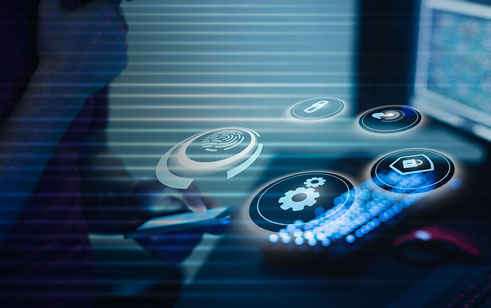Facial recognition is a method of identifying or confirming an individual’s identity using their face. Facial recognition systems can be used to identify people in photos, videos, or in real-time.
Computer algorithms are used by face recognition systems to identify specific, recognizable features on a person's face. The information is then transformed into a mathematical representation and contrasted with information on other faces gathered in a face recognition database. Instead of positively recognizing an unknown individual, some face recognition systems are built to determine the likelihood that the unknown person matches one or more database-stored face templates. Instead of only giving one result, these algorithms will present a number of potential matches, graded according to how likely they are to be the correct match. Different face recognition technologies have varying degrees of success in identifying persons in adverse situations like dim lighting, poor image quality, and an unfavorable angle of view.
FRS is a category of biometric security. The technology is mostly used for security and law enforcement, though there is increasing interest in other areas of use. In the following article, we have discussed how Banks and Financial Institutions Use Face Recognition to Protect People, Property, and Assets and to enhance their everyday functioning.
One of the main benefits that face recognition services can offer in the retail banking sector is its ability to offer e-KYC services. This enables consumers to take a selfie with a smart device and a copy of their identity document, which are shared with a financial institution. Face recognition technology can then verify this person’s identity against their documents when they wish to register with the financial institution. This offers great convenience to the end user, as it eliminates the need for a new customer to visit a physical bank location to verify their identity by sight.
Facial ID technology generally calls for a bank to require customers to take a selfie and also provide a document that displays their photo.
In conducting a "likeness" check of the image on the document, the technology analyzes eye placement, the distance of the eyes to the chin and other details. It also calls for a "liveness" check using advanced data analytics and machine learning that can detect if the selfie is a live person or a doctored photo. Customers in these situations are frequently required to turn their heads in different directions in order for the equipment to obtain a comprehensive scan.
Using passwords comes with a serious caveat: They’re based on what people know. Hackers can use any number of tactics to obtain that knowledge. But Facial recognition technology on a mobile device authenticates customers based on who they are as opposed to what they know. Facial recognition on a mobile device offers a second factor of authentication, with the first being possession of the device itself, and the second being a live facial image. The customers can access their bank accounts from computers or mobile phones. Facial Recognition software can be integrated via the webcams and in-built cameras in mobile phones. While logging into their account, facial biometrics is an additional layer of security. The software verifies a person’s identity before processing any transaction. Thus, Multi-factor authentication presents more barriers to fraudsters.
Banks are increasingly getting familiar with using facial identification to process transactions. But ATMs? That’s still the domain of plastic cards and PINs. Regrettably, there is a lot of fraud in this area. Criminals routinely use skimming devices to hack into ATMs.
FRS comes to the rescue in this case. Facial recognition can be integrated with ATM machines to create a system for unlocking cash machines with a face scan. This will limit ATM frauds and ensure that cash withdrawal transactions are safe and authentic. Customers who use face recognition online and at ATMs no longer need to carry bank cards and remember passwords, which provides a contactless interface and can reduce instances of fraud and lost cards.
Existing identity verification methods for e-commerce present problems for both shoppers and merchants. Shoppers forget their passwords or abandon purchases when the sign-in process is too time-consuming. Merchants lose business whenever this happens.
Here, FRS can be integrated for Faster transactions. The cardholder takes a selfie on their smartphone to securely – and quickly – authenticate their identity with the card network and the retailer. Customers can benefit from such a service as they will no longer need to handle physical currency and will also no longer need to carry payment cards nor remember passwords for credit card payments, enabling the user to have a pleasant shopping experience.

The World is growing at a rapid pace, and with that, advancements in information and communication technology are moving at a breakneck speed. In today's digital age, where information flows freely across the internet, the realm of law enforcement has undergone a unique transformation.
Learn More
Introduction : In a world where every frame tells a story and every pixel holds a clue, the landscape of law enforcement in India is undergoing a profound transformation.
Learn More
Radicalisation on social media is one of the major concerns in this digital age. Social media platforms act as a catalyst for extremist groups to propagate their ideas among vulnerable communities with the help of images, videos and texts in the form of hashtags, phrases specially to attract like-minded individuals who will follow and spread their information to reach a wider audience.
Learn More
In recent months YouTube channels have been overtaken by hackers. This series of security breaches experienced by a prominent YouTube channel is a stark reminder glassing the importance of implementing next-generation robust user/ permissions management systems for companies and individuals.
Learn More
Enhancing Images and Videos: The Solution to High-In today's rapidly evolving digital landscape, intelligent devices have transformed our daily lives. Real-time surveillance is crucial for ensuring security and safety.
Learn More